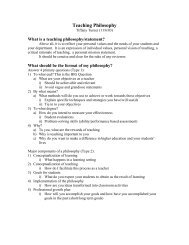Organic Chemistry, Game 17: Substitution and Elimination Reactions
Organic Chemistry, Game 17: Substitution and Elimination Reactions
Organic Chemistry, Game 17: Substitution and Elimination Reactions
Create successful ePaper yourself
Turn your PDF publications into a flip-book with our unique Google optimized e-Paper software.
<strong>Organic</strong> <strong>Chemistry</strong>, <strong>Game</strong> <strong>17</strong>: <strong>Substitution</strong> <strong>and</strong> <strong>Elimination</strong> <strong>Reactions</strong>(based on Volhardt <strong>and</strong> Schore, 3 rd edition, Chapter 7)game<strong>17</strong>_answers.doc 1 1/13/2003
<strong>Organic</strong> <strong>Chemistry</strong>, <strong>Game</strong> <strong>17</strong>: <strong>Substitution</strong> <strong>and</strong> <strong>Elimination</strong> <strong>Reactions</strong>(based on Volhardt <strong>and</strong> Schore, 3 rd edition, Chapter 7)Single Jeopardy Answers1. S N 2 RxnsAnswer50 S N 2 reactions proceed best with this type ofsubstrate.100 S N 2 reactions are much faster in these typesof solvents.150 S N 2 reactions are only possible with carbonsthat have this type of hybridization.200 S N 2 reactions are faster when this componentof the reaction mixture is small.250 S N 2 substrates undergo this uniquephenomenon during their transition states.Questions2. S N 1 RxnsPts Answer Questions50 S N 1 reactions are fastest with this type ofsubstrate.100 S N 1 reactions form these as part of theirmechanism.150 S N 1 reactions are faster in this type ofsolvent.200 S N 1 reactions are often undesirable becausethey destroy this desirable quality in thestarting material.250 This is the term used to describe S N 1 productmixtures, in which both enantiomers of theproduct molecule are present.3. E2 RxnsPts Answer Questions50 The rate of E2 is highest when a nucleophilehas this quality.100 E2 reactions are characterized by this type ofreaction order.150 This type of carbon hybridization is found inthe product molecules of E2 reactions.200 Mechanisms of the type found in E2reactions, in which the entire process happensin one step, are said to be this.250 E2 reactions normally, but not always,depend on the following stereochemicalrelationship.game<strong>17</strong>_answers.doc 2 1/13/2003
<strong>Organic</strong> <strong>Chemistry</strong>, <strong>Game</strong> <strong>17</strong>: <strong>Substitution</strong> <strong>and</strong> <strong>Elimination</strong> <strong>Reactions</strong>(based on Volhardt <strong>and</strong> Schore, 3 rd edition, Chapter 7)4. E1 RxnsPts Answer Questions50 E1 reactions convert alkyl halides to thisfunctional group.100 The rate determining step in E1 reactions isthe same as that in this type of reaction.150 E1 reactions are characterized by this type ofreaction order.200 The rate of E1 is highest when the solventpresent has this quality.250 The nature of this component has no effect onthe rate of E1 reactions.5. Between UsPts Answer Questions50 Increasing the concentration of a strong basein the reaction mixture will cause themechanism to shift from an E1 to this type ofreaction.100 Use a polar protic solvent, a good leavinggroup, <strong>and</strong> limit the basicity of thenucleophile to shift the product mixture tothis type of product rather than an S N 2.150 Big, bulky bases are likely to make a reactionproceed by this mechanism rather than anS N 2.200 A tertiary substrate with beta carbonbranching in the presence of a weak, bulkynucleophile should favor this mechanismrather than S N 1.250 This is the most important predictor ofwhether a reaction proceeds primarily by S N 1or S N 2.6. SolventsPts Answer Questions50 Polar protic solvents are necessary for E1 <strong>and</strong>S N 1 reactions because they facilitate thisinitial step.100 A change in solvent can alter this quality ofthe halides.150 These two types of substrates can not reactwith the solvents in which they are placed(i.e. they do not undergo solvolysisreactions).200 Acetone, DMF, <strong>and</strong> DMSO are solventswhich favor this type of reaction.250 These types of solvents are very poorionizers.game<strong>17</strong>_answers.doc 3 1/13/2003
<strong>Organic</strong> <strong>Chemistry</strong>, <strong>Game</strong> <strong>17</strong>: <strong>Substitution</strong> <strong>and</strong> <strong>Elimination</strong> <strong>Reactions</strong>(based on Volhardt <strong>and</strong> Schore, 3 rd edition, Chapter 7)Double Jeopardy Answers1. SolventsPts Answer Questions100 An example of a common polar protic solventis _____.200 Polar protic solvents are necessary for E1 <strong>and</strong>S N 1 reactions because they facilitate theinitial step.300 A change in solvent can alter this quality ofthe halides.400 The absence of a solvent means these 2 typesof reactions do not occur in the gas phase.500 An example of solvent in which an S N 1reaction will never occur is ______.2. Why N.R.?Pts Answer Questions100CH 3 OHCl OCH 3200CH 3 CH 2CH 3 CH 2 C OCH 3CH 3 CH 2NaBrCH 3 OH300 NaBrCH 3 CNCH 3CH 3 OH400Me 4 N BrCH 3 CH 2CH 3 CH 2 C BrCH 3 CH 2BrOTs hexane500 Br + HC CHBrCH+HBrgame<strong>17</strong>_answers.doc 4 1/13/2003
<strong>Organic</strong> <strong>Chemistry</strong>, <strong>Game</strong> <strong>17</strong>: <strong>Substitution</strong> <strong>and</strong> <strong>Elimination</strong> <strong>Reactions</strong>(based on Volhardt <strong>and</strong> Schore, 3 rd edition, Chapter 7)3. Rxn TypesPts Answer Questions100 Is an example of this type of reaction, inwhich a substrate reacts with its solvent.200 When this type of reaction is exothermic, itwill proceed before any others.300 The stereochemical consequence of this typeof reaction is likely to be a racemic mixture.400 This type of reaction results is stereochemicalinversion.500 This type of reaction can occur with primary,secondary, <strong>and</strong> tertiary substrates.4. CarbocationsPts Answer Questions100 When you see a carbocation, the three things you mustimmediately consider.200 Writing this type of carbocation on an exam is suicide.300 Of secondary, allylic, <strong>and</strong> benzylic substrates, thissubstrate forms the most energectically favorablecarbocation.400 Saturated carbocations are stabilized by thisphenomenon.500The reason the first carbocation islower in E than the other two.game<strong>17</strong>_answers.doc 5 1/13/2003
<strong>Organic</strong> <strong>Chemistry</strong>, <strong>Game</strong> <strong>17</strong>: <strong>Substitution</strong> <strong>and</strong> <strong>Elimination</strong> <strong>Reactions</strong>(based on Volhardt <strong>and</strong> Schore, 3 rd edition, Chapter 7)5. Well, Poor, N.R.Pts Answer Questions100CH 3H 3 CCCH 3 SO 2 OCH 2 CH 2 CH 2 CH 2 OH200BrCH 3 NO 2NaOHOOHO300I SCH 3NaSCH 3CH 3 OH400 NaOEtClEtOH500 CH 3 IOOIgame<strong>17</strong>_answers.doc 6 1/13/2003
<strong>Organic</strong> <strong>Chemistry</strong>, <strong>Game</strong> <strong>17</strong>: <strong>Substitution</strong> <strong>and</strong> <strong>Elimination</strong> <strong>Reactions</strong>(based on Volhardt <strong>and</strong> Schore, 3 rd edition, Chapter 7)6. KineticsPts Answer Questions100The figure is a reactioncoordinate diagram that belongsto this type of reaction.200The figure is a reactioncoordinate diagram that belongsto this type of reaction.300 The S N 2, E2, S N 1, <strong>and</strong> E1 reactions undergo this type ofcontrol, which means that, when a reaction can go by more thanone mechanism, the major product forms from the mechanismwhose transition state energy is the lowest.400 <strong>Reactions</strong> that follow this kinetic order, in which theconcentration of only one reagent determines the entire ratelaw, are said to be this.500 A reaction with a transition state energy higher than thisamount is unfavorable under normally available laboratoryconditions.game<strong>17</strong>_answers.doc 7 1/13/2003









